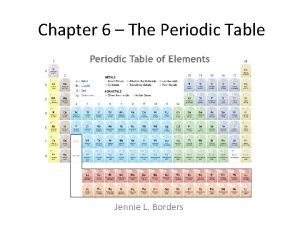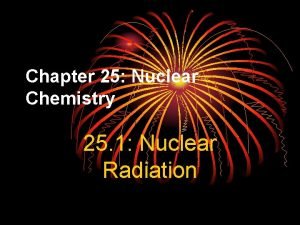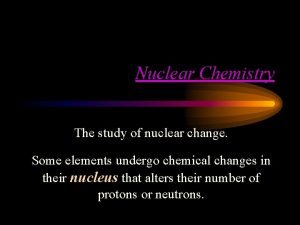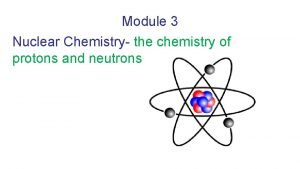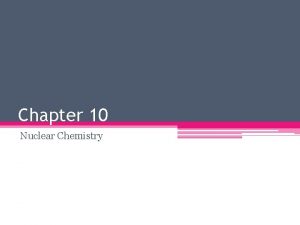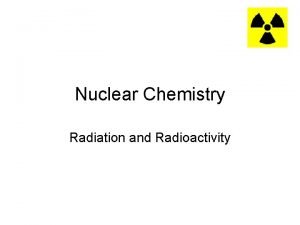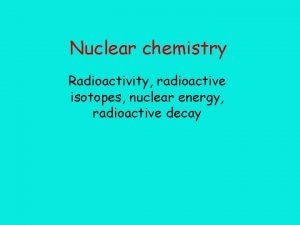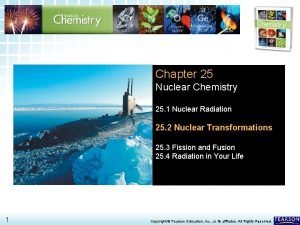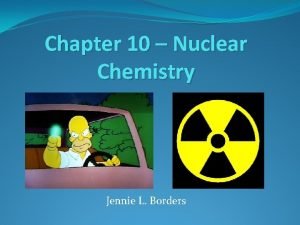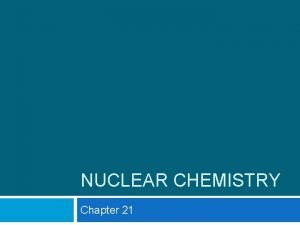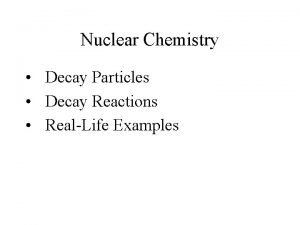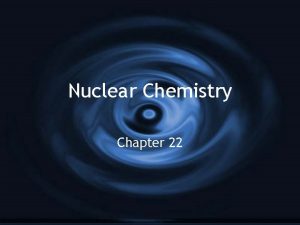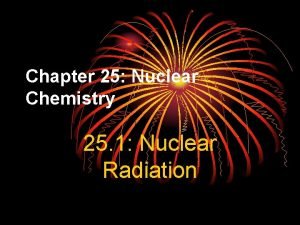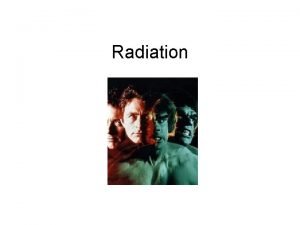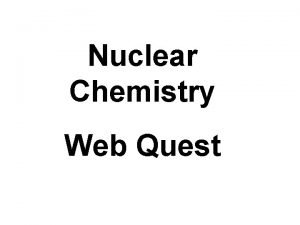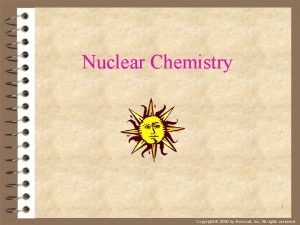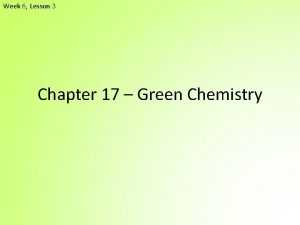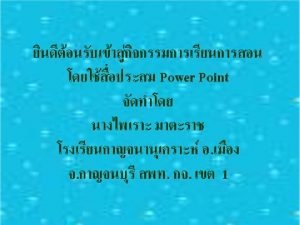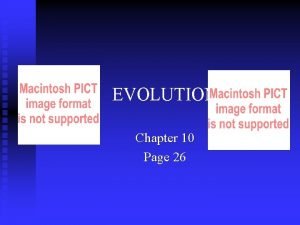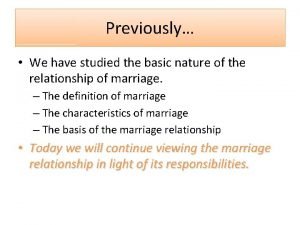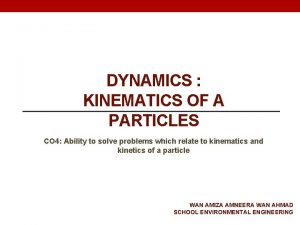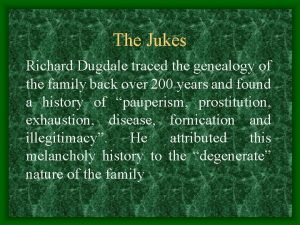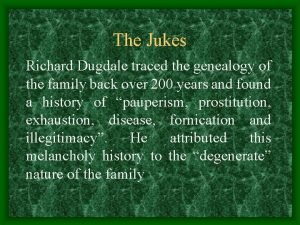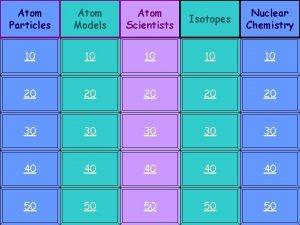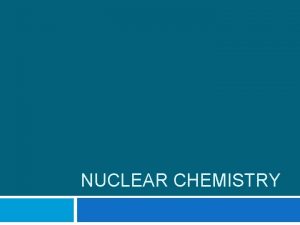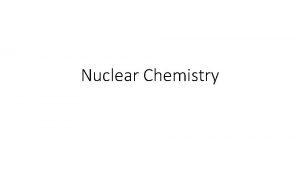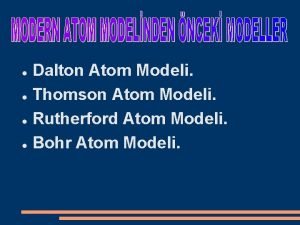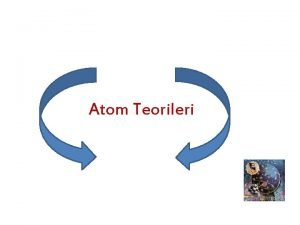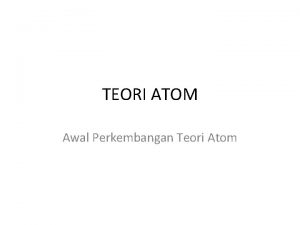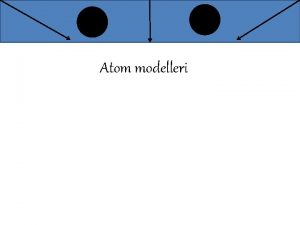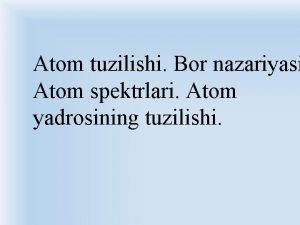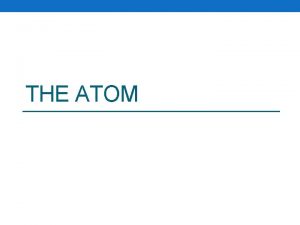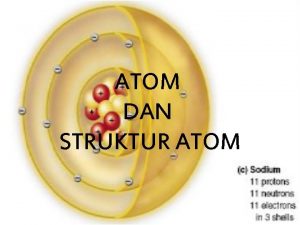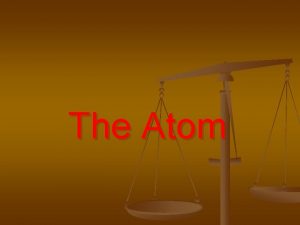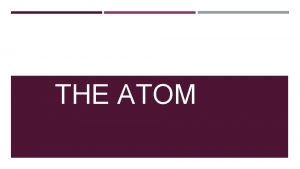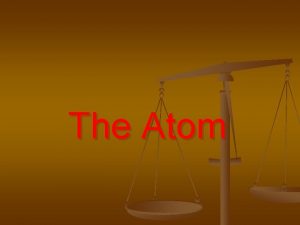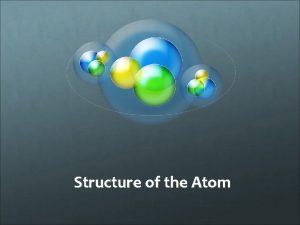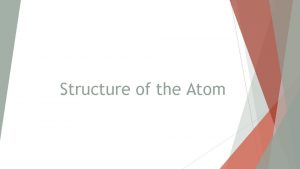NUCLEAR CHEMISTRY Nuclear Chemistry Who studied the atom










































- Slides: 42

NUCLEAR CHEMISTRY

Nuclear Chemistry


Who studied the atom?

Development of Atomic Models One of concept of atom was proposed by the ancient Greek philosopher, Democritus and his followers believed that every object or matter found in this world is composed by the minute, invisible, indivisible particles called atom. Atom is the simplest and smallest division of an object or matter. The word atom is derived from Greek atomos meaning “unable to be cut” According to Democritos, atoms are made up of precisely the same matter, but atoms of different elements differ in shape, size, weight, arrangement, and position. The size, shape, and arrangement of atoms of a substance determinethe substance properties. The followings are descriptions of atomic models development by scientists after Democritus and the modern atomic model believed at the present day.

Dalton’s Atomic Model In the early 19 -th century (1808), a British chemist and physicist “John Dalton” (1766 -1844) studied thoroughly how different elements, such as hydrogen and oxygen, could combine to form another substance ex. water. Dalton made two assertions about atoms, which is : a. Atoms of each element are all identical to one another, but different from the atoms of all other elements b. Atom of different elements can combine to form more complex substances

Dalton’s Atomic Theory (experiment based) 1) All elements are composed of tiny indivisible particles called atoms 2) Atoms of the same element are identical. Atoms of any one element are different from those of any other element. 3) Atoms of different elements combine in simple wholenumber ratios to form chemical compounds 4) In chemical reactions, atoms are combined, separated, or rearranged – but never changed into atoms of another element.

Limitations of Dalton’s atomic theory According to Dalton’s atomic theory atoms combine in the ratio of small whole numbers to form compounds. This is not seen in complex organic compounds like sugar C 12 H 22 O 11. Ratio of C, H and O is 12: 22: 11 which is not simple.

Thomson’s Atomic Model Since the discovery of electron as an elementary particle which is negatively charged, the validity of Dalton’s atomic theory begans to be questionable. In 1899, a british physicist, Sir Joseph Thomson, proposed : a. An atomic model callaed raisin plum pudding model. b. Thomson described atom as a positively charged sphere containing several negatively charged particles called electrons. Electrons are scattered in the sphere like raisins in a plum pudding + - + + +

Rutherford’s Experiment Observations (i) most of the α– particles passed through the gold foil undeflected. (ii) a small fraction of the α– particles was deflected by small angles. (iii) a very few α– particles (∼ 1 in 20, 000) bounced back, that is, were deflected by nearly 180°. Conclusions 1. Most of the space in the atom is empty 2. The positive charge has to be concentrated in a very small volume that repelled and deflected the positively 3. Rutherford showed that the volume occupied by the nucleus is negligibly small charged α– particles as compared to the total volume of the atom. The radius of the atom is about 10– 10 m, while that of nucleus is 10– 15 m.

Rutherford’s Atomic Model In 1911, Ernest Rutherford. Geiger and Marsden carried out an experiment by shooting the particles (α) on a thin plate of gold to prove the Thomson’s atomic theory or model as follows a. An atom consists of an atomic nucleus which is positively charged. The nucleus of atom contains almost entire mass of the atom and is surrounded by electrons which are negatively charged as in the solar system model b. Entirely, an atom is neutral because the number of its positive charges (protons) is equal to that of its negative charges. c. During revolving the nucleus, the centripetal force on electrons in an atom is produced by the forces of attraction between the electrons and nucleus ( coulomb force )

Defects in Rutherford’s model of atom (i) When electron (Negatively charged particle) revolve continuously around the positively charged nucleus then energy would be lost and due to the attraction of nucleus electron will merge with the nucleus. Rutherford has no explanation for this problem. (ii) If electron will continuously radiate energy then its spectra should be continuous but this is not the case. Atoms give line spectra. In order to overcome the defects of Rutherford Neil Bohr proposed the atomic model.

Bohr’s Atomic Model The weaknesses of Rutherford’s n=3 atomic theory in explaining the line spectrum of n=2 hydrogen atom was succesfully corerected by n=1 a Danish physicist, Neils Bohr, in 1913. Based on the Rutherford’s atomic theory and Planck’s quantum theory, Bohr proposed postulates dealing with an atomic model as follows : a. Electrons of an atom revolve around the nucleus at a certain path called stationary path. At This path, the electrons do not absorb or release energy and they have an angular momentum whose magnitude is the multiplication of b. Electrons will release energy (in the form photon) if they are moving from a higher to a lower energy level (from outer to the inner path) and the electrons will absorb energy when they are moving from a lower to a higher energi level (from the inner to the outer path)

Bohr’s Atomic Model c. Bohr’s atomic theory brings about the “Quantum number” concept. The principal quantum number in Bohr’s atomic theory represents the positive integer (n = 1, 2, 3 …. ) denoting the electron’s trajectory (orbit) in the atom as well as denoting the energy level of electron.

Subatomic Particles In the modern atomic theory, atom is composed by subatomic particles : electrons, protons and nuetrons. This statement has something to do with the discoveries of particles of electrons, protons and neutrons by the scientists, as we are going to study as follws. 1. The Discovery of Electron In 1897, Thomson discovered the value of specific charge of electron (e/m), that is the ratio of charge to mass of electron. To determine the value of e/m, Thomson used the magnetic and electric fields which are set in the path of electron. In 1906, Robert A. Millikan succeeded in determining the value of electron charge from oil drop experiment. In this case the value of e = 1, 6 x 10 -19 C is the value of an elementary particle, that is electron. Accordingly, from the value of specific change (e/m), the mass of an electron can be determined, that is 9, 11 x 10 -31 kg.

TYPES OF NUCLEIDE Type-I Based on protons and neutrons 1. Isotope is one of two or more species of an element atom having the same atomic number, but differ in mass number. The examples of isotopes are carbon isotopes, namely 2. Isobar is an atom which comes from different element but has the same mass number. The examples of the isobar are 3. Isotone is an atom which comes from different element but has same the number of neutrons. The examples of the isotone are 4. ISOMERS – two nuclei of the same species but different energy states, of which at least one is metastable

Nuclear Stability

Type-II Based on stability of nucleus Mattauch’s rule (1934): Adjacent isobars cannot be stable. 2 stable isobars separated by an unstable daughter. e. g. the isobar where A=40: 40 Ar, 40 K and 40 Ca Even vs. odd Magic #’s: 2, 8, 10, 28, 50, 82, 126 Nuclides with either Z or N = a “magic #” are more likely to be stable

Magic numbers 19 Actual # of n & p affects nuclear stability Even #’s of both n & p give stability Similar to noble gas electron configurations: 2, 10, 18, 36, etc. Since nucleons (= n+p) occupy energy levels within nucleus N or Z = 2, 8, 20, 28, 50, 82, and N = 126 Magic numbers

Nuclear stability. 20 In determining nuclear stability, ratio of neutrons to protons (N/Z) important Notice lower part of valley (N/Z = 1) Bi last stable (nonradioactive) isotopes N/Z too high: above valley, too many n, convert n to p, betadecay N/Z too low: below valley, too many p, convert p to n



Subatomic Particles In the modern atomic theory, atom is composed by subatomic particles : electrons, protons and nuetrons. This statement has something to do with the discoveries of particles of electrons, protons and neutrons by the scientists, as we are going to study as follows. 1. The Discovery of Electron In 1897, Thomson discovered the value of specific charge of electron (e/m), that is the ratio of charge to mass of electron. To determine the value of e/m, Thomson used the magnetic and electric fields which are set in the path of electron. In 1906, Robert A. Millikan succeeded in determining the value of electron charge from oil drop experiment. In this case the value of e = 1, 6 x 10 -19 C is the value of an elementary particle, that is electron. Accordingly, from the value of specific change (e/m), the mass of an electron can be determined, that is 9, 11 x 10 -31 kg.

The Discovery of Proton is a positively charged particle which was discovered by Eugen Goldstein through the continuation ray experiment. According to Goldstein, when cathode rays move toward the anode in Crookes tube, their particles will collide with the hydrogen gas in the tube. The collision will cause electrons of hydrogen atom to be released, making it hydrogen atom be positively charged in the form of hydrogen ion (H+). This ion moves toward the chatode through the hole and collidies at the glass wall behind the cathode. The hydrogen ion is then called proton and it has mass of 1, 67 x 10 -27 kg and charge of +1, 6 x 1019 C.

The Discovery of Neutron Ruhtherford was succesful in measuring (calculating) the mass of atomic nucleus which is approximately twice as much as mass of proton in the nucleus. Therefore, according to Rutherfor, there must be another particle in the nucleus and that particle is uncharged. It was not until 1932 that J. Chadwick discovered neutron from the shooting of beryllium using alpha particles and this neutron is, then, known as the paricle which has mass of approximately 1, 6 x 10 -27 kg PROTON NEUTRON ELECTRON



Penetrating power of radiation The ability of radioactive particles to pass through air and other materials is inversely related to their mass. Alpha particles – the least penetrating, they travel only a few centimeters through air. They can be stopped by a single sheet of paper. Beta particles – more penetrating, they travel several meters through air. They can be stopped by a sheet of Al or plastic. Gamma Rays – most penetrating, thick sheets of lead or concrete are required to stop gamma rays.







Nuclear Chemistry Nuclear (NOT Nucular) chemistry involves changes in the nuclear composition (protons and neutrons) of atoms that are radioactive. Nuclear reactions can be used as energy sources, for medical diagnosis, and for medical treatment.

Chemical Reactions Breaking/forming bonds via electrons Start and end with same number and type of atoms (conservation of mass) DH ≈ -1 - 1000 k. J Rates affected by temperature, pressure, concentration, catalyst

Nuclear Reactions Change one element into another via changes in nucleus (protons, neutrons) Change elements (lead CAN be turned into gold) DH can be -1010 k. J Rates can only be affected by changing concentrations

Chemical vs. Nuclear Reactions Chemical Reactions Nuclear Reactions Occur when bonds are broken Occur when nuclei emit particles and/or rays Atoms remain unchanged, although they may be rearranged Atoms often converted into atoms of another element Involve only valence electrons May involve protons, neutrons, and electrons Associated with small energy changes Associated with large energy changes Reaction rate influenced by temperature, particle size, concentration, etc. Reaction rate is not influenced by temperature, particle size, concentration, etc.

Two types of Nuclear Reactions Radioactive decay/emission: an unstable atom emits a particle or energy. This is a naturally occurring process and we can’t stop or change it. Example: Transmutation: when atoms are bombarded by particles, a reaction might occur Example:

Nuclear Reactions - Types When the target nuclei are bombarded by particles, there are some general types of interactions ØElastic Scattering When no energy is transferred between the target nucleus and the incident particle, the process is known as 208 Pb elastic scattering 208 Pb (n, n) 208 Pb, Q = 0. ØInelastic Scattering When energy is transferred, the process is called inelastic scattering 40 Ca (a, a') 40 m. Ca, Q == 0. where a and a' have different kinetic energies. In cases when the incident particle is a complicated nuclide, it may also be left in excited state, 208 Pb (12 C, 12 m. C) 208 m. Pb This process is called mutual excitation

Nuclear Reactions - Types ØCapture Reactions Both charged and neutral particles can be captured by nuclei. For example, 197 Au (p, g) 198 Hg 238 U (n, g) 239 U Neutron capture reactions are used to produce many radioactive nuclides. ØRearrangement Reactions The absorption of a particle accompanied by the emission of one or more particles is called a rearrangement reaction. 197 Au (p, d) 196 m. Au 4 He (a, p) 7 Li 27 Al (a, n) 30 P 54 Fe (a, d) 58 Co 54 Fe (a, 2 n) 56 Ni 54 Fe (32 S, 28 Si) 58 Ni Various rearrangement reactions change the number of neutrons and the number of protons of the target nuclide.

Nuclear Reactions - Types ØFission Reactions Typical and well-known neutron-induced fission reactions are: 235 U (n, 3 n) fission products 239 Pu (n, 3 n) fission products These reactions release energy. The released neutrons induce further reactions, causing contineous chain reactions. ØFusion Reactions The fusion reaction of deuterium and tritium is particularly interesting because of its potential of providing energy for the future. T (d, n) He
 Fisión nuclear vs fision nuclear
Fisión nuclear vs fision nuclear Lesson 15 nuclear quest nuclear reactions
Lesson 15 nuclear quest nuclear reactions The structure of the atom section 2 defining the atom
The structure of the atom section 2 defining the atom Kelemahan model atom thomson
Kelemahan model atom thomson Zeff trend
Zeff trend Chapter 25 nuclear chemistry
Chapter 25 nuclear chemistry Applications of nuclear chemistry
Applications of nuclear chemistry Nuclear chemistry
Nuclear chemistry Nitrogen-13 decay equation
Nitrogen-13 decay equation Chapter 24: nuclear chemistry answer key
Chapter 24: nuclear chemistry answer key Chapter 10 nuclear chemistry
Chapter 10 nuclear chemistry Nuclear chemistry
Nuclear chemistry Application of nuclear chemistry
Application of nuclear chemistry Irradiated food
Irradiated food Chapter 25 nuclear chemistry answer key
Chapter 25 nuclear chemistry answer key Chapter 10 nuclear chemistry
Chapter 10 nuclear chemistry Chapter 21 review nuclear chemistry
Chapter 21 review nuclear chemistry Types of decay
Types of decay Application of nuclear chemistry
Application of nuclear chemistry Chapter 25 nuclear chemistry
Chapter 25 nuclear chemistry Anatomy of a wave
Anatomy of a wave Nuclear chemistry webquest
Nuclear chemistry webquest Copyright
Copyright Atom economy in green chemistry
Atom economy in green chemistry We've recently studied the
We've recently studied the If you had studied hard you would have succeeded
If you had studied hard you would have succeeded The most studied group is
The most studied group is As darwin studied fossils what new questions arose
As darwin studied fossils what new questions arose We've recently studied the
We've recently studied the Did you do your homework last night?
Did you do your homework last night? George gray poem analysis
George gray poem analysis Qualitative quantitative
Qualitative quantitative Natural history of disease is best studied by
Natural history of disease is best studied by The motion of a projectile is often studied in terms of
The motion of a projectile is often studied in terms of Qualitative and quantitative data analysis
Qualitative and quantitative data analysis Requirement analysis case study
Requirement analysis case study Been + ving
Been + ving Dugdale
Dugdale Chapter 4 cell theory and cell study
Chapter 4 cell theory and cell study Undefined status sociology definition
Undefined status sociology definition Theories of interpersonal attraction
Theories of interpersonal attraction Dugdale criminology
Dugdale criminology Bổ thể
Bổ thể




